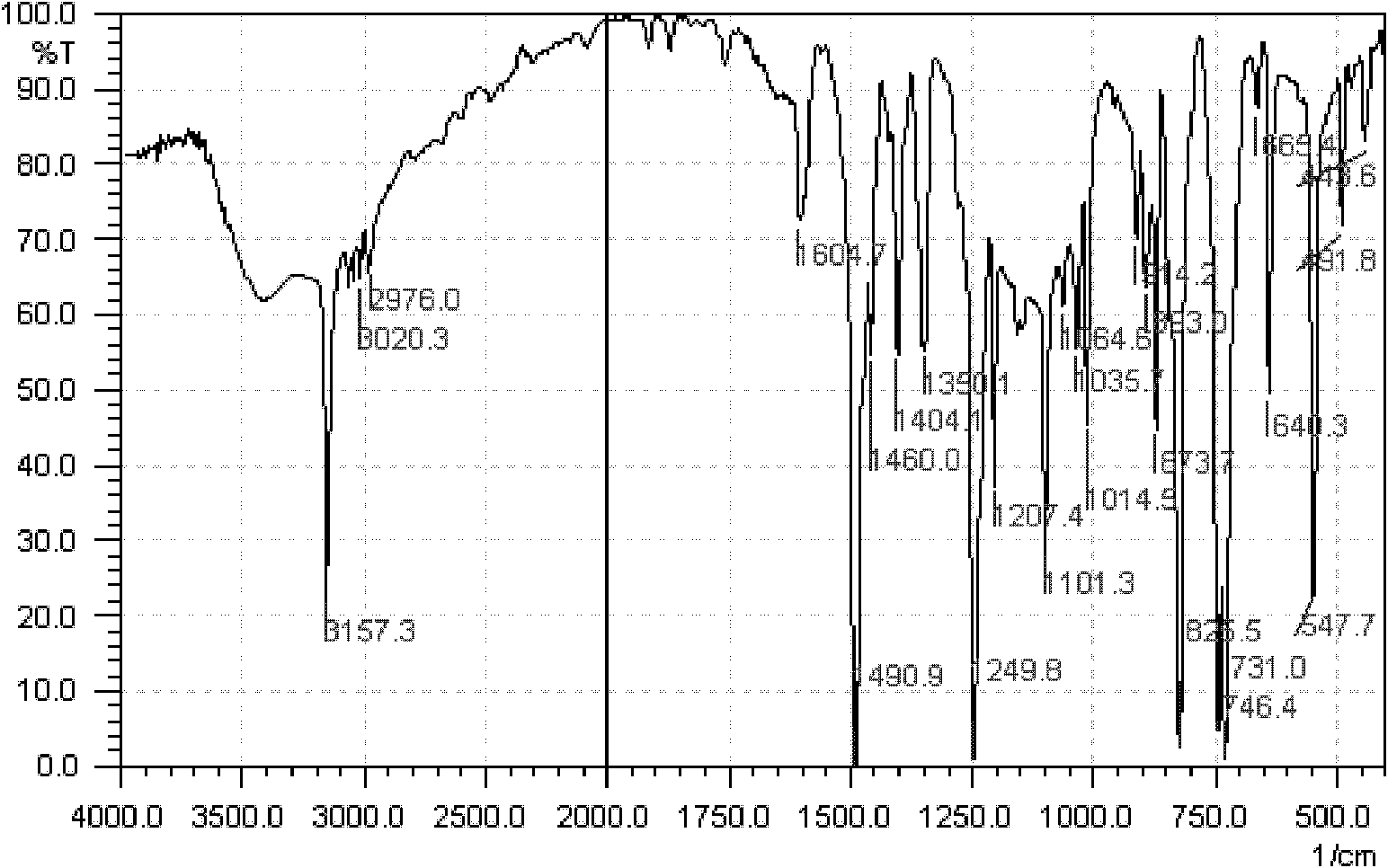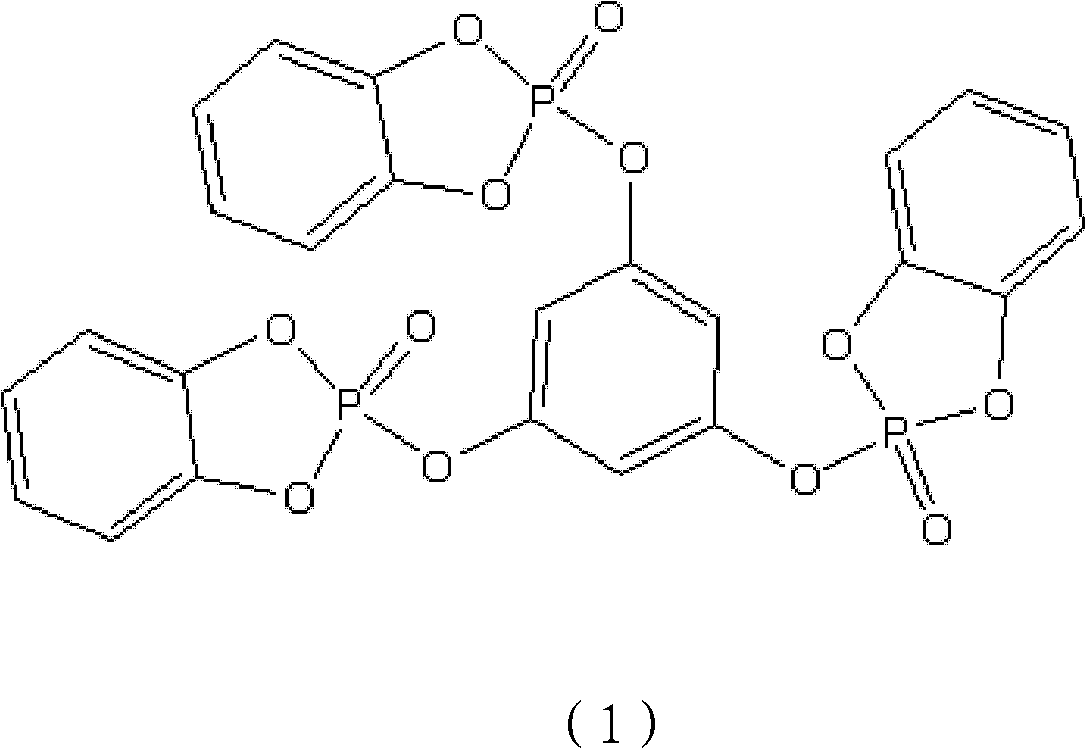Novel fire retardant tri(1,3-dioxa-2-phospho hetero-2-oxo-1,2-indane) m-cresyl phosphate and preparation method thereof
A technology of phloroglucinol phosphate and indane, which is applied in the field of phloroglucinol triphosphate and its preparation, can solve the problems of poor flame retardant effect and high cost, and achieve good flame retardant effect and low cost. Inexpensive, good degradability effect
- Summary
- Abstract
- Description
- Claims
- Application Information
AI Technical Summary
Problems solved by technology
Method used
Image
Examples
Embodiment 1
[0026] All glassware used in the experiment was cleaned and dried. Put 1.10 g (0.01 mol) of catechol into a 250 ml three-necked flask, and then dissolve catechol with 5 ml of chloroform. 5.05 g (0.05 mol) of triethylamine and 4.56 g (0.03 mol) of phosphorus oxychloride were respectively placed in a constant-pressure dropping funnel, and slowly added dropwise to the three-necked flask after being heated to 70 degrees. After the dropwise addition was completed, the reaction was continued for 1 hour. Then, distillation under reduced pressure was carried out. Below 65 degrees, vacuum distillation was performed for 30 minutes to remove excess phosphorus oxychloride, and then 0.50 g (0.004 mol) of phloroglucinol and 3 ml of chloroform were added while hot. Then take 3.03 g (0.04 mol) of triethylamine and 3 ml of chloroform into the dropping funnel, slowly add it dropwise, control the temperature at 40 degrees, and react for 5 hours. Below 70 degrees, vacuum distillation was perfo...
Embodiment 2
[0028] All glassware used in the experiment was cleaned and dried. 1.10 g (0.01 mol) of catechol was put into a 250 ml three-necked flask, and then 6 ml of chloroform was used to dissolve catechol. Take 8.08 g (0.08 mol) of triethylamine and 6.84 g (0.045 mol) of phosphorus oxychloride and place them in a constant pressure dropping funnel, respectively, and add the temperature to the three-necked flask slowly dropwise at 35 degrees. After the dropwise addition, the reaction was continued for 4 hours. Then, distillation under reduced pressure was carried out. Below 100 degrees, vacuum distillation was performed for 10 minutes to remove excess phosphorus oxychloride, and then 1.26 g (0.01 mol) of phloroglucinol and 4 ml of chloroform were added while hot. Then take 2.02 g (0.02 mol) of triethylamine and 4 ml of chloroform into the dropping funnel, slowly add it dropwise, control the temperature at 60 degrees, and react for 3 hours. The temperature was controlled below 70 degr...
Embodiment 3
[0030] All glassware used in the experiment was cleaned and dried. Put 1.10 g (0.01 mol) of catechol into a 250 ml three-necked flask, and then dissolve catechol with 5 ml of chloroform. Take 2.02 g (0.02 mol) of triethylamine and 1.672 g (0.011 mol) of phosphorus oxychloride and place them in a constant pressure dropping funnel, respectively, and slowly add dropwise to the three-necked flask at a temperature of 10 degrees. After the dropwise addition was completed, the reaction was continued for 10 hours. Then, distillation under reduced pressure was carried out. Below 65 degrees, vacuum distillation was performed for 30 minutes to remove excess phosphorus oxychloride, and then 1.51 g (0.012 mol) of phloroglucinol and 3 ml of chloroform were added while hot. Then take 4.04 g (0.04 mol) of triethylamine and 5 ml of chloroform into the dropping funnel, slowly drop it, control the temperature at 10 degrees, and react for 9 hours. The temperature was controlled below 70 degree...
PUM
| Property | Measurement | Unit |
|---|---|---|
| limiting oxygen index | aaaaa | aaaaa |
| limiting oxygen index | aaaaa | aaaaa |
Abstract
Description
Claims
Application Information
 Login to View More
Login to View More - R&D
- Intellectual Property
- Life Sciences
- Materials
- Tech Scout
- Unparalleled Data Quality
- Higher Quality Content
- 60% Fewer Hallucinations
Browse by: Latest US Patents, China's latest patents, Technical Efficacy Thesaurus, Application Domain, Technology Topic, Popular Technical Reports.
© 2025 PatSnap. All rights reserved.Legal|Privacy policy|Modern Slavery Act Transparency Statement|Sitemap|About US| Contact US: help@patsnap.com



